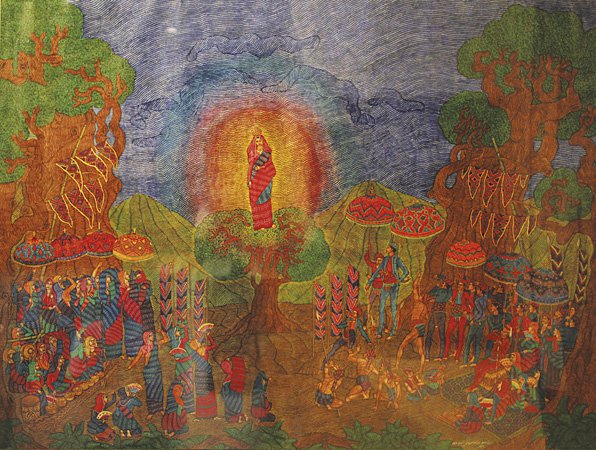Cultural Center of the Philippines
ENCYCLOPEDIA OF
PHILIPPINE ART
Tulak-Bala
(Warding Off Catastrophe) / 1999 / Watercolor on paper / 104 x 131 cm / Artist: Saudi Ahmad / Artist’s collection
The painting depicts a scene in which a woman floats above a tree as people gather around and observe her from a distance on the ground. The woman appears as an apparition as indicated by the expression of the people surrounding her whose poses suggest deference to a holy presence or respect toward an authority figure. Set against a backdrop of mountains and foliage, the crowd appears to be a family of nobility accompanied by their entire entourage. The scene is meticulously rendered in detail, from the figures’ colorful attires to the various objects they are holding. On the left side are mostly women wearing blouses with sashes and cloth wrapped around their bodies. These women carry colorful parasols, fans, and banners. On the right side are mostly men wearing turbans and headgear, and holding weapons such as spears and swords, which suggest they are warriors. The painting is executed in the artist’s trademark nuanced colors made up of transparent layers which produce rich linear patterns and textures that unify the entire composition. The artist’s painstaking technique of producing this subtle blending of watercolors gives the painting its vitality and character.
This work is a fine example of figurative painting from the Islamic south, an underdeveloped art form that has not become popular due to the attitude of orthodox Islamic theologians who preach against figurative art (Sakili 2006). The painting demonstrates that this notion of absolute prohibition of figurative representation in Islamic art continues to be challenged. It exemplifies how still fairly unknown contemporary Islamic Filipino artists possess a penchant for vibrant colors. The painting is also a showcase of folk Islamic artistic sensibility in that the works of Ahmad have gained worldwide recognition. Coming from the Maguindanao group, Ahmad is known for his brilliant palette that he employs to chronicle festivities and everyday events such as the Hariraya festival, weddings, harvests, and burials.
Though representative of a stream of folk Islamic art from the Philippines, the painting relates to Catholic traditions, which pose the Virgin Mary as a ubiquitous icon. This is a motif that has been traced to the presence of older representations of a mother goddess indicative of a precolonial matrilineal society (Fajardo 1998). This artwork is part of the exhibition The Philippine Contemporary: To Scale the Past and the Possible at the Metropolitan Museum of Manila, 2013-16.
Written by Ryan Francis Reyes
Sources
Fajardo, Brenda. 1998. “Filipina as Mother and Other Identities.” In Perspectives on the Vargas Museum Collection: An Art Historical and Museological Approach, edited by Patrick Flores, 63-68. Quezon City: Department of Art Studies and Jorge B. Vargas Museum.
Sakili, Abraham P. 2006b. “Muslim Figurative Painting: Issues and Prospects.” Pananaw: Philippine Journal of Visual Arts, Jan.
